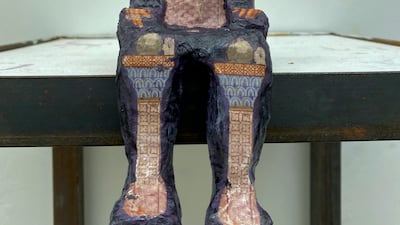On opening day, 101’s Playing Spaces exhibition nearly sold out, with more than half of the artworks on view reserved. Not a bad record for an art platform that is only three months old.
The week-long show, which could be viewed online and at Alserkal Avenue in Dubai, is refreshing, filled with works crafted in various mediums by young, emerging artists – Alaa Edris, Asma Belhamar, Talal Al Najjar, Nasir Nasrallah and Malda Smadi – who are not yet signed with commercial galleries.
This is part of 101's grassroots approach to showcasing and selling art, an ethos developed by its founders, writer Gaith Abdulla and curator Munira Al Sayegh. An art collecting and research platform, 101 marked its first exhibition in Abu Dhabi's Bait 15 in August. Playing Spaces is its second sale and first show in Dubai, as well as the platform's first foray into public programming.
Abdulla and Al Sayegh hope to appeal to younger or first-time collectors, who may feel intimidated by the frenzy of traditional, pre-pandemic art fairs and the at-times chilly atmosphere of galleries. This ethos is evident in their quirky and creative programming. On opening night, for example, 101 held a flashlight-guided viewing of the exhibition, essentially a tour in the dark. Wielding their smartphones, attendees shone their flashlights on to the works, discussing themes and ideas with the curators.
The rest of the week will include activities that stretch well into the early hours, 1:01am to be exact, including a creative writing session, a doll-making workshop with one of the artists and a discussion with the curators. All these activities delve into the "the heart of our concept", says Abdulla, specifically "conversation, community and critique".
The artists in the show are all Emirati, except for Smadi, and are in their early twenties to early thirties. Artwork prices range from $450 to $5,445.
Al Najjar's series of sculptures, Ancient Contemporary, take on the form of ancient artefacts while covered in contemporary clippings of pop culture references. Three of the five on display have already been reserved. Meanwhile, Belhamar's delicate architectural drawings and paintings are already sold out.
Edris's digital photo compositions also touch on architecture, though bear her more mysterious, signature sci-fi style. Smadi demonstrates the range of her practice, with works of painting, mixed media and photography, while Nasrallah's pieces focus on figurative and whimsical paintings.
"Believe it not, there are very few opportunities here for young and emerging artists to show in exhibitions such as this," Smadi said. She added that 101 has not only provided exposure in the arts hub setting of Alserkal Avenue, but also accessibility to collectors through the platform's website.
"101 challenges the idea that an artist must have gallery representation to significantly sell or exhibit," Al Najjar said, highlighting that the platform offers direct contact with "art collectors, the wider art market and art communities in the Gulf and beyond".
Abdulla says he and Al Sayegh seek to include “artists who are serious about their practice and who we see have potential to progress", adding that their more than decade-long involvement with the regional artistic community gives them a richer perspective into the concerns of local talent, particularly when it comes to gallery representation.
“When you showcase artists together, they become blood brothers,” says Al Sayegh. “Curatorially, it’s really important for us to know the artists’ work and how they fit thematically with one another,” she explains, noting that the works in the show are tied together by concepts of movement, play and architecture.
As part of its aims, 101 also hopes to promote what Abdulla calls “ethical collecting”, which he defines as an “informed and educated” as well as “social and political”, where the collector gains a deeper knowledge of the artist and their work. It is “collecting as beyond a financial transaction".
The platform’s way of doing business is also atypical. While most commercial galleries split the proceeds of a sale 50 / 50, 101 gives 70 per cent to the artist and keeps the rest. Additionally, unsold works return to the artist.
“When you’re collecting, you’re building a history alongside that collection. Your relationship with the collection reflects what you’re thinking and what you think is important,” adds Al Sayegh. It extends the act of collecting beyond aesthetic considerations towards social and political engagement.
While it is still early days for 101, their trajectory is promising so far. Al Sayegh says she spotted returning collectors who first visited their Bait 15 exhibition, and the platform has attracted those outside of the usual UAE art scene, another goal for the founders. "That's what we are aiming for. We've had people say 'thank you for making this [exhibition] accessible and less scary'. This is what I would consider success," says Al Sayegh.
Details on how to sign up for workshops can be found on 101's website or Instagram page







